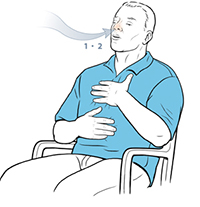A
B
C
D
E
F
G
H
I
J
K
L
M
N
O
P
Q
R
S
T
U
V
W
X
Y
Z
Click a letter to see a list of conditions beginning with that letter.
Click 'Topic Index' to return to the index for the current topic.
Click 'Library Index' to return to the listing of all topics.
Pursed-Lip Breathing
Pursed-lip breathing can help you get more oxygen into your lungs when you're short of breath. When you start to feel short of breath, use pursed-lip breathing to control your breathing. Breathing in through the nose and out through pursed or closed lips makes breathing easier. You can practice breathing this way anytime, anywhere. For instance, if you're watching TV, practice during the commercials. Try to practice several times a day. Over time, pursed-lip breathing will feel natural.
Home care
Practice these steps every day so that you'll know how to do pursed-lip breathing when you have shortness of breath.
-
Sit in a comfortable chair.
-
Relax the muscles in your neck and shoulders.
-
Breathe in slowly through your nose.
-
Hold your lips together as if you're trying to whistle or blow out a candle.
-
Breathe out slowly and gently through your pursed lips. Your exhale should be twice as long as your inhale.
-
Repeat the above steps as needed.
Use pursed-lip breathing to prevent shortness of breath when you do things such as exercising, climbing stairs, or bending or lifting. Breathe out during the hard part of any activity, such as when you bend, lift, or reach. Always breathe out for longer than you breathe in. This lets your lungs empty as much as possible. Never hold your breath when doing pursed-lip breathing.


Follow-up care
Make a follow-up appointment, or as advised by your healthcare provider.
When to call the healthcare provider
Call your healthcare provider or seek medical care right away if you have any of the following:
-
Shortness of breath, wheezing, or coughing
-
Increased mucus, or yellow, green, or bloody mucus
-
Fever of 100.4°F (38°C) or higher, or as directed by your healthcare provider
-
An irregular heartbeat
-
Swollen ankles
Call 911
Call 911 right away if any of these occur:
-
Trouble breathing
-
Tightness in your chest that doesn't go away with rest or medicine
-
Can't talk
-
An irregular heartbeat that's making you more short of breath or lightheaded, confused, or dizzy
-
Other symptoms as directed by your healthcare provider
Online Medical Reviewer:
Chris Southard RN
Online Medical Reviewer:
Rajadurai Samnishanth Researcher
Online Medical Reviewer:
Rita Sather RN
Date Last Reviewed:
9/1/2024
© 2000-2024 The StayWell Company, LLC. All rights reserved. This information is not intended as a substitute for professional medical care. Always follow your healthcare professional's instructions.